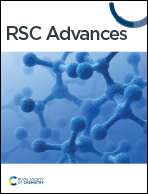Latent bloodstain detection using a selective turn-on NIR fluorescence dye responsive to serum albumin†
Abstract
Bloodstain detection can provide crucial information and evidence at a crime scene; however, the ability to selectively detect bloodstains in a non-destructive manner with high sensitivity and low background is limited. This study reports a fluorescent dye (sulfonate indolizine squaraine, SO3SQ) for bloodstain visualization under near-infrared (NIR) irradiation. While the dye itself is minimally fluorescent in aqueous solution, it exhibits a “turn-on” mechanism upon binding with human serum albumin (HSA) as the fluorescence intensity increases over 160 times with strong absorption and emission at 693 nm and 758 nm, respectively. Bloodstains can be visualized on a surface even after being diluted 1000 times, and washed latent bloodstains can be detected with high sensitivity. Further, the turn-on fluorescent emission lasts for a minimum of seven days, allowing adequate time for detection. This study also indicates that the SO3SQ can sensitively detect bloodstain after the bloodstain aged for one week. Furthermore, the detection of latent blood fingerprint patterns from colorful backgrounds is demonstrated using this non-destructive method. The selective turn-on fluorescent dye with NIR excitation and emission is highly suitable in forensic science for bloodstain visualization.



 Please wait while we load your content...
Please wait while we load your content...